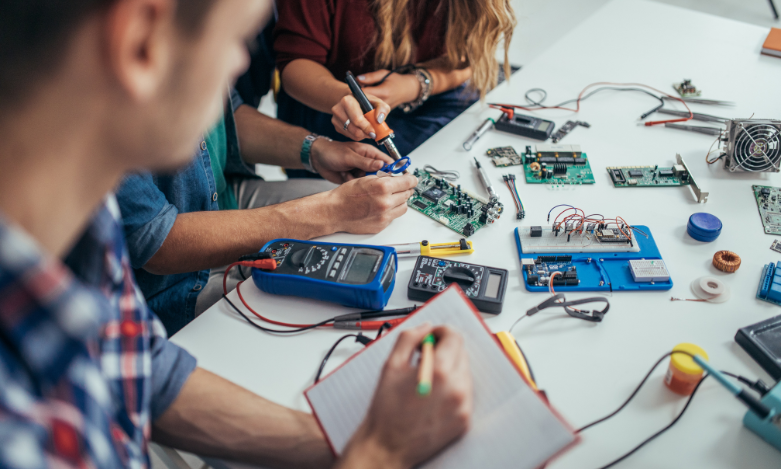Hybrid Battery Life Cycle Testing Using CompactRIO
- Apr 24, 2023
- 4 min read
Updated: Mar 27, 2024
*As Featured on NI.com
Original Authors: Abedalsalam Bani-Ahmed, Center for Sustainable Electrical Energy Systems, University of Wisconsin–Milwaukee
Edited by Cyth Systems

The Challenge
Developing an automation system to evaluate the performance and cycle life of a hybrid lithium-ion/lead-acid battery.
The Solution
Combining CompactRIO FPGAs and processors to create a rugged, reliable automation system that charges/discharges a lithium-ion/lead-acid hybrid battery to evaluate performance and cycle life. The controller monitors the system's voltages, currents, and temperatures and commands the source, load, and relay to maintain continuous charging/discharging cycles in an unsupervised manner. The controller also runs a protection algorithm and streams data to the HMI client for logging.
Introduction
A part of the Center for Sustainable Electrical Energy Systems at the University of Wisconsin-Milwaukee, the Power and Electronics and Electric Drives Lab focuses on electrical energy generation and conversion. We integrate multiple energy conversion and storage devices to design systems that provide the most effective, efficient, and reliable means of providing power to loads. These research projects develop technologies for multiple industries and build a talent pipeline for companies in Southeastern Wisconsin.
Battery cycle life testing is time-consuming and the most important procedure in battery qualification test. The battery/system under test is subjected to repeated charge/discharge cycles to determine its cycle life. For our lithium-ion/lead-acid hybrid battery, there are two cycling and capacity check tests. The cycling test includes charging/discharging the combined batteries 1,000 times at a 0.3 C rate. After every 50 cycling tests, we perform a capacity check to measure the capacity of the combined system. The capacity check test includes one cycle of fully charging and discharging the system at 0.1 C. Moving from charging to discharging circuit can take up to one hour and involves disconnecting the source and reconnecting to the load. Additionally, safety hazards arise because we must perform this operation manually and close to the system approximately every three hours.
The goal of the tests is to evaluate the performance and cycle life of the combined batteries to find the feasibility of this combined energy storage for use in multiple utility level applications, including energy harvesting, peak shifting, and frequency regulation. We have conducted several lab scale tests and examined different combined configurations to evaluate the charge and discharge characteristics and cycle performance of the combined batteries.
Left: Schematic of the combined batteries: 7 Lithium-ion batteries and 2 Lead-acid batteries are connected in parallel. Right: NI CompactRIO hardware.
System Overview
The combined batteries are seven lithium-ion batteries (LIBs) connected in series and two lead-acid batteries (LABs) connected in series. The seven LIBs are connected in parallel with the two LABs, as Figure 1 shows.
Table 1 summarizes the electrical characteristics of each battery cell under test. Figure 2 illustrates the electrical connection of the source and load to the strings along with the voltage, current, and temperature sensors.
During the charging cycle, the CompactRIO hardware triggers the relay and the relay energizes the contactor to connect the source to the combined batteries. During the discharging period, CompactRIO discharges the relay, which leads to disconnecting the source from the terminals. Then the digital load is turned on to perform the discharging cycle.
Advantages of Using NI Products
Without NI products, we would have to perform many time-consuming and hazardous operations manually. For example, disconnecting the source from the circuit and connecting the load, and vice versa. Programming the source and the load, if needed at each cycle, can be time-consuming. Average testing time for one cycle is seven hours. Handling the circuit exchange manually takes about one hour (two hours per cycle).
We used CompactRIO hardware for system automation. We programmed the FPGA with the NI 9215, NI 9220, and NI 9480 analog input modules for acquiring three different types of signals (voltages, currents, and temperatures). We used LabVIEW software for programming. An NI real-time target runs the control and automation algorithm and communicates with the source and load over serial communication lines using the NI 9870 modules. Data logging runs on the HMI client and communicates with the controller over TCP/IP.
The flexibility to add different modules to CompactRIO, based on the project needs, is what makes it the best candidate at the design stage. LabVIEW block-based programming is easy to learn and does not require extensive programming experience. In addition, we can monitor the whole system remotely, which minimizes the hazard of being around the running system of batteries, which is under intense testing.
Because NI products have been used for years in our lab, NI hardware and programming software became viable platforms in many project setups. We can use FPGA for data acquisition and computational purposes to meet the processing requirements. For example, our system requires data logging every one second. At the same time, data acquisition cannot be interrupted, because CompactRIO is busy with the control algorithm that also includes a hard real-time protection mechanism that requires the system to shut down within milliseconds in case of emergency. CompactRIO was a good choice because the real-time controller receives the data from the FPGA target and runs the algorithm separately, and transmits the collected data to the logging VI running on the computer as a network variable. This makes the system distributed over three different processing units without interruption.
We programmed our system exclusively with LabVIEW and using the LabVIEW Real-Time and LabVIEW FPGA modules. We programmed the FPGA to acquire continuous data acquisition and faster responses for possible battery faults. Also, because the system runs unsupervised, we programmed it to send any emergency reports through our email server directly from CompactRIO.
Original Authors:
Abedalsalam Bani-Ahmed, University of Wisconsin–Milwaukee
Edited by Cyth Systems








